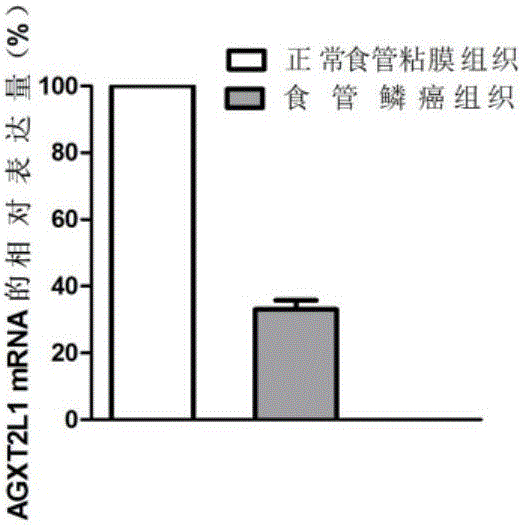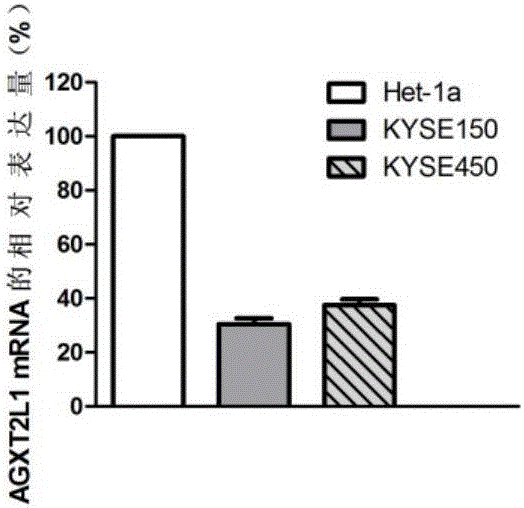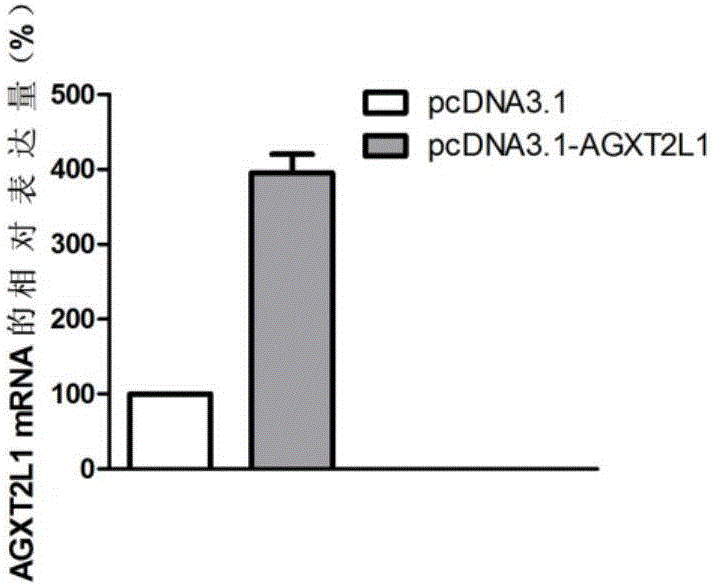Molecular target of esophageal squamous carcinoma
A technology for esophageal squamous cell carcinoma and products, applied in the field of biomedicine
- Summary
- Abstract
- Description
- Claims
- Application Information
AI Technical Summary
Problems solved by technology
Method used
Image
Examples
Embodiment 1
[0057] Example 1 Screening for gene markers associated with esophageal squamous cell carcinoma
[0058] 1. Sample collection
[0059] 6 cases of surrounding normal esophageal mucosa tissue and esophageal squamous cell carcinoma tissue were collected, and the patients all gave informed consent. All the above samples were obtained with the consent of the organizational ethics committee.
[0060] 2. Preparation of RNA samples (operated using QIAGEN tissue RNA extraction kit)
[0061] Take out the tissue samples frozen in liquid nitrogen, put the tissue samples into a pre-cooled mortar for grinding, and extract and isolate RNA according to the instructions in the kit. details as follows:
[0062] 1) Add Trizol and place at room temperature for 5 minutes;
[0063] 2) Add 0.2ml of chloroform, vibrate the centrifuge tube vigorously, mix well, and place it at room temperature for 5-10min;
[0064] 3) Centrifuge at 12000rpm for 15min, transfer the upper aqueous phase to another new...
Embodiment 2
[0076] Example 2 QPCR sequencing to verify differential expression of AGXT2L1 gene
[0077] 1. Large-sample QPCR verification of differential expression of AGXT2L1 gene. According to the sample collection method in Example 1, 50 cases of surrounding normal esophageal mucosa tissues and 50 cases of esophageal squamous cell carcinoma tissues were selected.
[0078] 2. RNA extraction The steps are the same as in Example 1.
[0079] 3. Reverse transcription:
[0080] Use 25μl reaction system, take 1μg total RNA for each sample as template RNA, and add the following components to PCR tubes: DEPC water, 5× reverse transcription buffer, 10mM dNTP, 0.1mM DTT, 30μM Oligo dT, 200U / μl M-MLV, template RNA. Incubate at 42°C for 1 hour, then centrifuge briefly at 72°C for 10 minutes.
[0081] (3) QPCR amplification test
[0082] Primer design
[0083] The primer sequence of the housekeeping gene GAPDH is:
[0084] Forward primer: 5'-CTCTGGTAAAGTGGATATTGT-3' (SEQ ID NO.3)
[0085] Re...
Embodiment 3
[0097] Example 3 Differential expression of AGXT2L1 gene in esophageal cancer cell lines
[0098] 1. Cell culture
[0099] Human esophageal squamous cell lines KYSE 150 and KYSE450 were purchased from Cancer Institute, Chinese Academy of Sciences, and normal esophageal epithelial cell line Het-1a was purchased from Guangzhou Geneo Company. In DMEM containing 10% fetal bovine serum and 1% P / S at 37°C, 5% CO 2 , Cultivated in an incubator with a relative humidity of 90%. Change the medium once every 2-3 days, and use 0.25% EDTA-containing trypsin for routine digestion and passage.
[0100] 2. Extraction of RNA
[0101] 1) Digest the adherent cells with trypsin, and the cells obtained by pipetting are centrifuged, resuspended, washed, and then resuspended in 1640 medium (10% calf serum);
[0102] 2) Transfer the resuspended cells to a 6-well plate ( / well), add medium to 2m1 / well, shake the 6-well plate to resuspend the cells evenly;
[0103] 3) The cells were adhered to the ...
PUM
 Login to View More
Login to View More Abstract
Description
Claims
Application Information
 Login to View More
Login to View More - R&D
- Intellectual Property
- Life Sciences
- Materials
- Tech Scout
- Unparalleled Data Quality
- Higher Quality Content
- 60% Fewer Hallucinations
Browse by: Latest US Patents, China's latest patents, Technical Efficacy Thesaurus, Application Domain, Technology Topic, Popular Technical Reports.
© 2025 PatSnap. All rights reserved.Legal|Privacy policy|Modern Slavery Act Transparency Statement|Sitemap|About US| Contact US: help@patsnap.com



